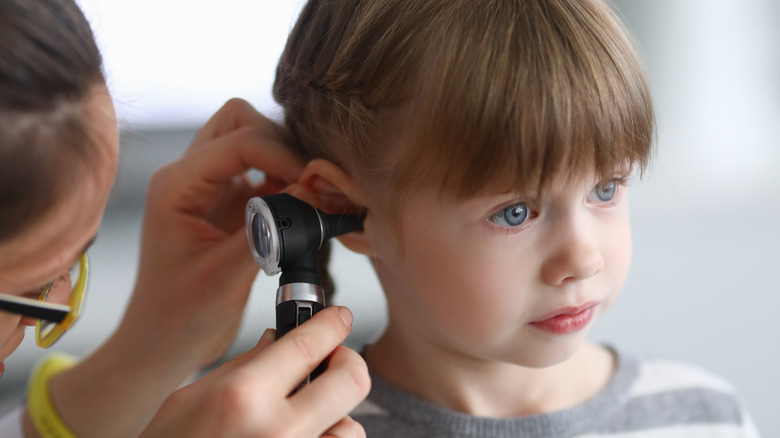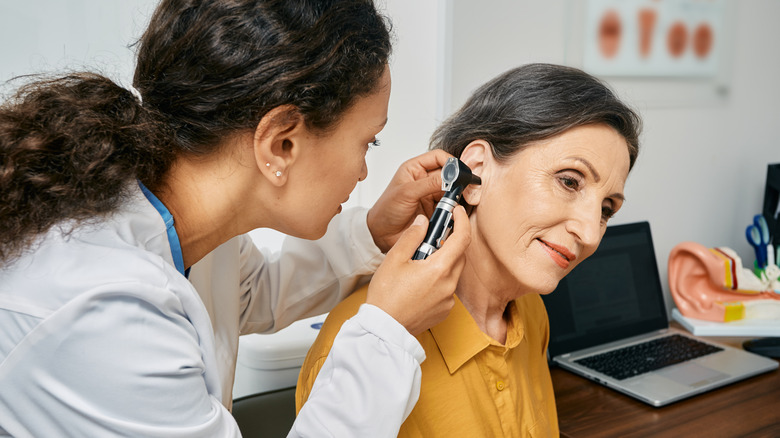Ear infections are one of the most common reasons for doctor visits among children in the United States, according to the National Institute of Deafness and Other Communication Disorders. It is estimated that around 80% of children will have at least one ear infection by school age, per a 2024 study published in StatPearls. Children are more susceptible to ear infections because their eustachian tubes are more narrow and horizontal, making them more susceptible to blockages as well as viruses and bacteria, per Nemours Kids Health. In addition to children, ear infections can also occur in adults although they aren’t as common, states Medline Plus.
The pain and discomfort, alongside the pressure and fullness associated with an ear infection, can make it difficult to fall asleep or stay asleep. It is best to seek medical attention if you suspect you have an ear infection in order to get proper treatment and alleviate the symptoms. It’s also important to understand the causes and types of ear infections, which have been examined below.
Types of ear infections

There are several types of ear infections, each with its own set of symptoms and causes. Acute otitis media (AOM) is the most common and occurs when the middle ear becomes infected and inflamed, per the Mayo Clinic. Otitis media with effusion (OME) occurs when there is still fluid in the ear after the initial infection has passed, per Medical News Today. Symptoms may not always occur, but the fluid can be seen when checked by a doctor. Chronic otitis media (COM), a long-term ear infection, can also occur when fluid repeatedly comes into the middle ear, per Medical News Today. Lastly, external otitis (swimmer’s ear) is an infection that affects the outer ear canal. It happens when water enters and becomes trapped in the ear, allowing bacteria to grow. Symptoms of external otitis include ear pain, itching, and drainage from the ear, per the Mayo Clinic.
The symptoms of ear infections can vary depending on the severity of the infection and the type of infection. The most common symptoms of an ear infection include pain in the affected ear, which might worsen when lying down, says the Mayo Clinic. This pain might cause issues when sleeping, hence we’ve provided a few tips below to get a good night’s sleep when you have an ear infection.
Use a memory foam pillow

Using a memory foam pillow when you have an ear infection will help provide the adequate support your head and neck needs, which may help reduce pain and improve sleep quality (via Sleep Family). Memory foam is a type of polyurethane foam that is known for its ability to conform to the shape of a person’s body and distribute weight evenly. It was first developed by NASA in the 1970s for use in airplane seats, but it has since become a popular material for mattresses, pillows, and other types of bedding, per NASA.
The position in which you sleep while dealing with an ear infection makes a big difference as well. Sleep Family recommends sleeping on the same side as your noninfected ear so that the infected ear is facing up. This position along with adding some extra pillows to elevate your head will help to promote drainage and therefore reduce the pressure in your infected ear, which will hopefully allow you a restful sleep.
Apply a warm compress

fizkes/Shutterstock
A warm compress is a method of applying heat to a specific area of the body using a heated pad, cloth, or bag filled with warm water or other heating elements. The heat helps to increase blood flow to the area, which can relieve pain and discomfort, reduce inflammation, and promote healing, per the Cleveland Clinic. To do a warm compress, you will need a clean, soft cloth and warm to hot water but not boiling. According to Healthline, you must first fill a bowl with hot water, soak the clean cloth in the water and wring out the excess. Carefully place the warm compress on the affected area, and cover it with a dry towel to keep the heat inside. Leave the warm compress in place for 20 minutes or as directed by a doctor or healthcare professional.
It’s important to note that warm compresses are not suitable for everyone. It’s best to consult with a doctor or healthcare professional if you’re unsure whether a warm compress is appropriate for your condition.
Use pain medications

Ground Picture/Shutterstock
If you can’t find relief via a warm compress, memory foam pillow, or altered sleeping position, fortunately, there are other effective methods to help you manage an ear infection. If the pain is intense, over-the-counter pain relievers such as ibuprofen or acetaminophen can be very helpful, according to the Cleveland Clinic. Additionally, some over-the-counter ear drops contain pain relievers and anti-inflammatory agents that can help to reduce pain and inflammation in the ear, per the clinic. Another remedy you might want to try is putting a couple of drops of hydrogen peroxide in the ear for a few minutes before letting it drain out. You can also gently swab ginger juice around the outer ear canal as a pain relief method.
Be sure to follow the recommended dosage on the packaging of any medication used. Also, note that these tips are not a substitute for professional medical advice and should be used alongside a doctor’s recommendations. It is always best to consult a healthcare professional before trying any new treatment or remedy.
When to see a doctor for an ear infection

Peakstock/Shutterstock
It is particularly important to see a doctor if the ear pain is severe or accompanied by a high fever, severe headache, or stiff neck, as these symptoms may indicate a more serious condition such as meningitis, a common complication of severe ear infection, per a 2024 article published by Loyola University Health System. Additionally, if an ear infection is suspected and the person has a history of recurrent ear infections, or if the person experiences hearing impairment, it is important to seek medical attention immediately.
Treatment for ear infections can vary depending on the type and severity of the infection. For some cases of ear infections, your doctor might wait for a few days to see if the symptoms improve without treatment; if not, then the doctor will provide the appropriate treatment.
Antibiotics are sometimes used for bacterial ear infections and can be administered orally or topically (ear drops), per the Mayo Clinic. It’s important to complete the full course of antibiotics, even if symptoms improve before the medication is finished, to ensure that the infection is fully treated.



